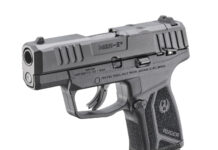
The Croatian VHS-2 carbine is the latest European service rifle to grace US shores. It joins the AUG and the X95 in the list of available serving bullpup rifles that are commercially available. Springfield Armory, using their existing relationship with HS-Produkt (maker of the XD series pistols), completed the lengthy import process for the rifles, and managed to Americanize them a bit for our use at the same time.
But does this rifle compete favorably in a market owned by the AR-15 and AR derivatives? Does it have a place as a modern service rifle? Or is it merely an interesting collector’s piece for military rifle folk who like that they can purchase another of the NATO chambered service weapons of Europe?
The “Hellion”
Let’s get the name out of the way first.
I hate it. It’s stupid.
Hellion: a rowdy, mischievous, or troublemaking person, especially a child.
I bet it sounded cool in a boardroom somewhere and fit the odd pseudo macho vibe… but what was wrong with VHS-2 Carbine? This is an Americanized VHS-K2 and that is just fine. Springfield even teased it with this image.

That’s what it is, the VHS-2. It isn’t a trouble making child, it’s a 5.56x45mm NATO service rifle. We aren’t calling it the Hellion, it’s the VHS-2.
End of rant about the name.
The VHS-2
I won’t go down the whole description from Springfield Armory, it’s here and HS-Product’s is here.
The short version is that the Springfield imported VHS-2 is another European military bullpup, Americanized. It is a product of its Croatian service origin with a few popular and necessary US centric features. The crucial points are the suppressor tuned gas system (replacing the ‘adverse’ overgassing, if I recall correctly), the STANAG magazine insert, and the M-LOK compatible handguard and BCM pistol grip.
Here is the Springfield variant

And here is the comparable HS-Produkt variant, VHS-K2

Similar, but notable exterior differences. Consider it like how H&K does the HK416F for France and the M27 for the Marine Corps, this is the VHS-2 for the American market.
From Front to Butt(stock)
The 16″ CMV barrels are melonite treated, a feature I appreciate greatly in newer rifles, and capped with a serviceable 4-prong flash hider. Replaceable with your preference of 5.56 muzzle device.
The handguard is a 9 slot M-LOK variant instead of bolt-on NATO Picatinny rails. The side M-LOK isn’t quite 3 and 9 o’clock, more like 2:30 and 9:30, featuring a slight upward angle. The gas regulator is adjustable by hand and, as mentioned above, the setting is now to reduce the gas to run a suppressor instead of an ‘adverse’ overgas setting. Excellent feature set for this market space. The Coratian VHS-2’s are not designed to be fielded suppressed, but the American market loves it some shush tubes.
The Springfield VHS-2 adds QD sling sockets to the traditional European keyring type points at the front and back. Both sides of the rifle feature a forward point at the front of the handguard, forward and below the M-LOK slots (which could also mount a QD point). Two more are positioned just below the rear sight base, mid-receiver. The final two are at the rear of the stock in accordance with modern designs.
Now, let’s talk about these iron sights.

Actually no, let’s have HS-Produkt and Springfield Armory take a bow for these sights. The iron sight suite on the VHS-2 is phenomenal. It is an all finger adjustable front and rear, no pushing detents or crimping cases to twist anything. The front sight is fully shielded, with its adjustment dial below it. It features a finely tapered post that will aid accuracy. The rear sight has 5 appetures for distances in meters and calibrated with SS109/M855 NATO Green Tip 62gr ammunition. The sights lock in the down and up positions, no knocking them down against gear or the environment, and they are spring loaded to pop up with the corresponding buttons. The sight housings themselves are shorter than corresponding AR height systems, so a co-witness may not be feasible.
The top rail is uninterrupted picatinny, add your optics and other zeroables. Under that optical and sight rail is the charging handle, it is ambidextrously accessible and stows centerline. It will fold out to either side to cycle the gun. The safety selector drum is rotary, however the motion is more akin to a pull and push than the 45, 60, or 90 degree throws we are conditioned to in AR type rifles.
The pistol grip, a BCM MOD3, is mounted in an even more vertically aligned angle than it would be on an AR-15. The AR-15 compatible grip index has a rearward biased tilt, an interesting choice, but also one I do not dislike.
There are two ejection ports, one will be in the pinned closed position (default is the left) and the other will open when the bolt cycles. They are polymer and held under spring tension, like an AR-15, with a detent holding it closed and the bolt carrier nudging open as it cycles. Swapping ejection is a simple process, covered in the manual and online in easy to follow steps.
The stock has a molded riser section that fits nicely for a cheek or chin weld. With this shaped piece the VHS-2 can be fired from off shoulder, with brass passing in front of the shooter’s face, very easily since the shooter will more naturally index the gun with their face behind the ejection ports. The stock is adjustable for length of pull, a rare feature in bullpups, with 5 positions covering 1.5 inches of adjustable length.

The overall length of pull is long for rifles in general, like almost excruciatingly long, but works with the reward weight bias of a bullpup. It was not uncomfortable to shoot, just far longer than average and put your hands very close together towards the front of the rifle.
The magazine well is an insert and can be replaced with a different one for different magazine formats, the native HS-Produkt insert is for G36 style magazines while the Springfield import VHS-2 wisely uses STANAG AR format. The release is a rear paddle style that fits with the H&K and AK styled ergonomic origins, more on that later.
Behind that is the bolt release, a large tab that travels rearward. There is no external bolt catch, only the internal tab that interfaces with an empty magazine. Behind the large bolt release tab is a small nub that actually holds the trigger system in place and can be used to remove it when the rifle is disassembled.
Does it blend?
Where the VHS-2 came from is fairly obvious. The AK-47 was the previous large inventory service rifle of the Croatian Army, and the G36 was the largest purchased NATO standard service rifles before they built up the VHS for domestic service. While 750 G36 rifles may not seem like a large number, the Croatian Military has ~7,500 active members.
So, when the forces were looking to fix the VHS issues (resulting in the VHS-2) they had G36’s on hand as local NATO rifle example. Its influence can be seen in the charging handle, although the VHS-2’s doesn’t reciprocate, the safety selector, the magazine and bolt hold open system, all of it feels like a bullpup’d G36.
Where that becomes a limitation is in the handling.
To make this review a succinct as I can, the VHS-2 as a standalone is a perfectly adequate service carbine. It will serve well in most any role that you’d use any other mag fed semi-auto in. It can host all the modern force multiplicative options you’d want, lights, optics, and slings, and suppressor.
Where it runs into a wall is in smooth handling and manual of arms. The manual of arms is very much late 1900’s Europe and not 2020’s shooter optimized. The magazine release, bolt catch, and bolt release all point to a simplified and suboptimal manual of arms where you will not be able to run the rifle as fast as other designs. It borrows on the G36 and AK here, but that puts a hard limit on the options to keep the rifle fed with ammo.
The VHS-2’s reload a bolt lock mechanics are the most tedious, especially when coming off of an AR or X95 which operate with very well thought out economy of motion. I’ll explain.
On the VHS-2, to lock the bolt you must hold the charging handle to the rear and manually reach inside magazine well and press up on the bolt lock tab. There is no external control. This isn’t much more than an annoyance with an empty rifle, but on a stoppage where you might want to lock the bolt open you must manually hold the bolt reward instead. Even in this scenario it is more annoyance than flaw but it is a limit on my handling options.
The real problem is in reloading. The VHS-2 does not leverage drop free magazines or an intuitive bolt release motion.
When you fire the final round in a VHS-2, the bolt locks to the rear. Good. On an AR, AR Derivative, or an X95 you can now simultaneously grab a new magazine and hit your magazine release control. Even if the magazine doesn’t drop free when you hit the release on these rifles, you can pull the magazine free very easily before inserting the full one. On the VHS-2, with its paddle style release, you are married to the HK manual of arms which mandates the shooter first pull the magazine out of the magazine well. Then the shooter can go to an ammunition pouch for a fresh magazine.
No matter how many times or ways I tried to grab a magazine and then pull the VHS-2’s mag out with the new magazine in hand, I couldn’t make it a smooth series of movements. The smoothest reloads I had were always strip the empty magazine, pull and insert the full magazine, and then sweep my support hand back along the bolt release almost like I was working a pistol slide. There was no way, at least not with my hand size, to push back on the bolt release with just my thumb.
What these limitations mean is I cannot economize my reload movements and the controls are making my hands move in contrary directions for efficacy. I got good at the reload motions, very reminiscent of reloading an MP5, but the AR, X95, and similar have a significant economy of motion advantage.
Will this matter? Under certain circumstances it absolutely will. Competitive shooting environments most prominently. Any situation where the reload mechanics are utilized the VHS-2 hits that hard limit. Now, I will say I believe it is a touch better than an AK’s mechanics, but many AKs I can grab my reload magazine before clearing the empty magazine, so it is a close call.
Compare it to the X95, where the magazines will drop free reliably and the bolt release is in a location and moves in a direction that works within the economy motion, and the X95 can be reloaded much more quickly.
When clearing hard stoppages, the VHS-2’s ambidextrous charging handle and location come in handy. It is easy to manually keep the bolt pulled and brace the rifle into the chest to clear out problems, similar again to the AK and G36. There is no real limitation here and a double feed, stove pipe, etc. should be a quick clear, refeed, and on with life.
Conclusion?
The VHS-2 is a capable 5.56 rifle in its own right with several strong design features. It is not done any favors by its trigger, but the aftermarket may solve that. It’s real limitation is in its magazine manipulations, but those are designed around its progenitors and it does make sense to keep as much of a trained manual of arms as can be retained. That doesn’t translate as well outside the military market though, you will simply be unable to run this rifle as fast or efficiently as others in the space past the first magazine.
That is the VHS-2’s only major limitation however.
If you like it, buy it and learn to run it. This same criticism can be leveled at the AK and MP5 (the whole roller lock series actually) and doesn’t diminish their overall efficacy or how enjoyable they are as firearms on their own. Someone who can run this reasonably efficiently will not be outclassed by a neophyte with an AR-15.
I think it will find a comfortable niche and expand bullpup enjoyment here in the states. The aftermarket could take it and run a few rather nice upgrades.



